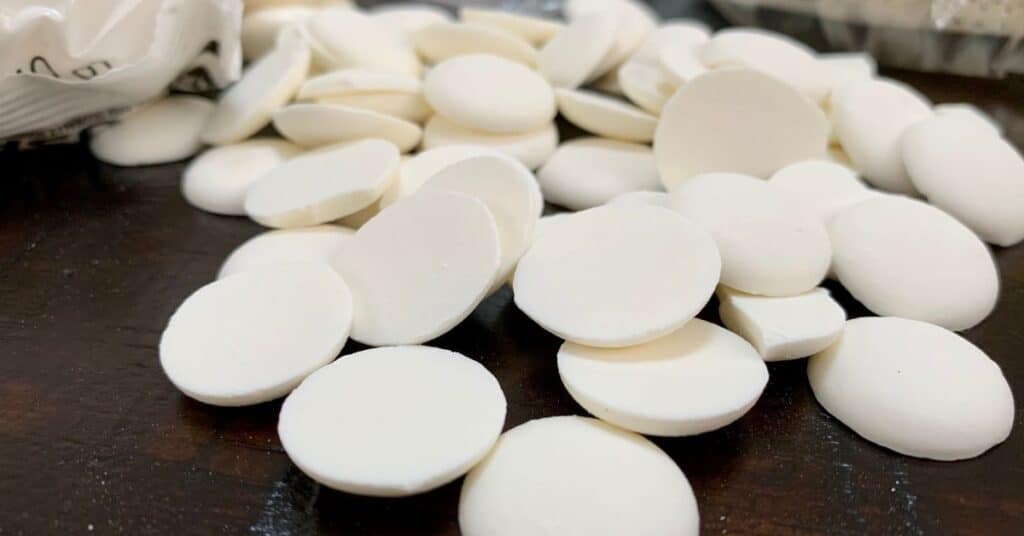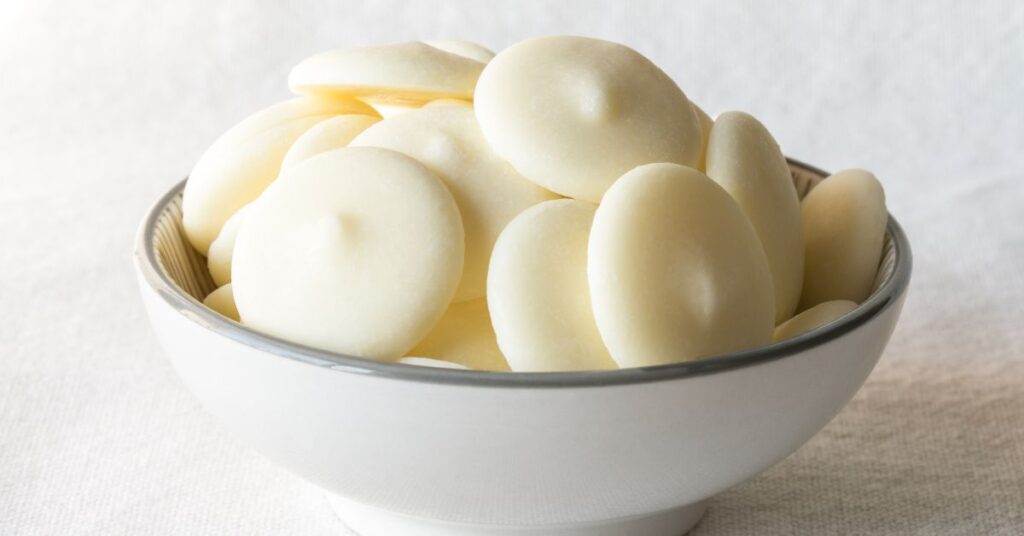When you’re in the kitchen creating sweet treats, you might come across recipes that call for either melting wafers or candy melts. These ingredients are staples in the world of confectionery for coating and decorating, but they offer different qualities and uses. Melting wafers are often real chocolate that requires tempering to achieve a glossy finish and crisp snap. They come in various cocoa percentages, which allow you to control the level of sweetness and chocolate intensity in your desserts.

On the other hand, candy melts, also known as compound coatings or summer coatings, are made from sugar, milk solids, vegetable oils, and flavorings. One of their main advantages is convenience, as they don’t need tempering like chocolate wafers. This means you can melt them easily, and they’ll set without fuss, making them a go-to for quick decorating tasks. Candy melts come in a wide range of vibrant colors, which makes them particularly appealing when you’re looking to add a splash of color to your creations.
Comparing Chocolate Wafers and Candy Melts
When crafting your confections, understanding the differences between chocolate wafers and candy melts is essential for optimal results. Your choice affects not only the flavor and texture but also your ease of use during melting.
Composition Differences
Chocolate Wafers are typically made from cocoa butter, cocoa solids, sugar, and sometimes milk, which create that authentic chocolate flavor. Cocoa butter, a crucial ingredient, allows the wafers to melt smoothly and gives a characteristic mouthfeel.
On the other hand, Candy Melts are often oil-based, lacking cocoa butter and sometimes cocoa solids. They consist mainly of sugar, milk solids, and vegetable fats. This composition makes them more stable but less like true chocolate in flavor and creaminess.
Melting Characteristics
- Chocolate Wafers have a sensitive melting point due to cocoa butter. If not carefully heated, they can become clumpy or burn easily.
- Candy Melts have a higher tolerance for heating, thanks to the vegetable oils. They don’t require tempering, which makes them a go-to for convenience and consistent results.
Properly melting chocolate wafers generally requires gentle heat and sometimes a double boiler to prevent scorching, whereas candy melts are hardier, allowing you to melt them without as much fuss.
Taste and Texture Profiles
Chocolate wafers:
- Provides a rich chocolate taste because of the cocoa components
- Deliver a smooth and velvety texture, which usually reflects quality
- Can vary in flavor, from bittersweet to milk or even white chocolate wafers
Candy melts:
- Have a sweeter, milky flavor, often less nuanced than real chocolate
- Offer a more consistent but different texture which might not showcase the snap or melt-in-the-mouth quality of chocolate wafers.
When selecting between chocolate wafers and candy melts, consider that the taste will directly relate to the presence of cocoa products. In contrast, the texture will be influenced by cocoa butter in chocolate wafers, setting them apart from the more uniform texture of candy melts.
Practical Uses in Baking and Decorating

Melting wafers and candy melts provide you with versatile options for embellishing your desserts. Whether you’re creating intricate shapes or simply adding a pop of color, these materials can be tailored to fit your decorating needs.
Molding and Coating
When using candy molds, you’ll find that both melting wafers and candy melts are excellent for molding due to their smooth consistency and firm setting properties. For cake pops, melt your choice of chocolate, then dip the pop to create a smooth, hard coating that’s ready for additional decorating.
- Molding:
- Spoon melted candy into the mold.
- Tap to remove air bubbles.
- Coating:
- Dip cake pops into melted chocolate.
- Tap off excess coating.
Decorative Drizzle
To add visual interest, consider using a decorating bag to drizzle melted chocolate or candy melts over cookies, cakes, or pastries. The thin stream of color can elevate the appearance of your treats.
- Drizzling Steps:
- Fill a decorating bag with melted chocolate.
- Cut a small tip and drizzle over desserts.
Coloring Techniques
Candy melts come in various colors, but you can customize melting wafers using oil-based food coloring to achieve the hue you desire. This is key for intricate decorating work where specific colors are needed for detail.
- Color Mixing:
- Add a few drops of oil-based food coloring to white chocolate.
- Stir gently until you achieve the desired color.
Remember to avoid water-based food coloring, as it can cause the chocolate to seize. Use bold strokes or delicate touches to bring your vision to life.
Melting Techniques and Tips

When melting wafers or candy melts, your main goals are to achieve a smooth consistency and prevent the mixture from seizing. Knowing the right techniques can make the melting process simple and efficient.
Microwave Melting Method
To melt wafers or candy melts in the microwave, start by placing them in a microwave-safe bowl. Heat them at 50% power in 30-second intervals, stirring in between each interval until smooth. This gradual process helps to maintain a consistent texture and temperature, reducing the risk of overheating.
- Microwave Power: Half (50%)
- Intervals: 30 seconds
- Temperature: Melt until smooth and fully liquid
Note: Microwaves may vary, so adjust the power and time as needed to avoid burning the melts.
Stovetop Melting Tips
The double boiler method is optimal for stovetop melting. Fill the bottom pot with about an inch of water and bring it to a simmer, not a full boil. Place the wafers or candy melts in the top pot and stir gently as they melt. This indirect heat helps in tempering chocolate, allowing it to reach the perfect melting point without overheating.
Key Steps:
- Simmer water on low heat.
- Stir melts constantly until smooth.
- Double Boiler: Ensure water does not touch the bottom of the top pot.
- Heat: Low simmer
- Stirring: Constant
Tips:
- Heat the melts until they’re just melted to help retain perfect consistency.
- Always keep the water at a simmer to prevent the chocolate from getting too hot.
Preventing and Fixing Seizing
Seizing occurs when moisture is introduced to the melted candy, causing it to become thick and grainy. To prevent it, ensure all utensils and the bowl are completely dry before use. If seizing happens, you can try to rescue the mixture by gradually adding paramount crystals or vegetable oil, stirring until the desired consistency is restored.
- Prevention: Keep all tools and bowls dry.
- Fix: Add paramount crystals or vegetable oil.
Amounts:
- Add 1/2 teaspoon of oil or crystals at a time.
- Stir well after each addition.
Keep melts at room temperature to maintain the perfect texture for use in your creations.
Selecting the Right Product for Your Project

When you embark on a confectionery creation, the success of your project often hinges on the ingredients you choose. Whether you’re crafting intricate chocolate shapes, coating sweets, or simply dipping fruit, the type of chocolate matters.
Factors Influencing Choice
Your choice between melting wafers and candy melts should take into account texture, flavor, ease of use, and the final appearance of your project. Melting wafers and candy melts vary in flavor and quality, and each suits different applications:
- Texture and Flavor: Couverture chocolate, known for its high cocoa butter content, melts smoothly and has a superior flavor. Merckens white chocolate is a popular choice for a creamy and rich flavor profile.
- Ease of Use: Candy melts, also referred to as summer coating, are a fuss-free alternative to traditional chocolates. They do not require tempering, which can be a pivotal consideration if you’re short on time or new to candy making.
- Appearance: For a glossy finish, couverture chocolate, when properly tempered, is ideal. Candy coatings, while not as shiny, still provide a smooth surface and vibrant color options.
Understanding Different Options and Substitutes
When deciding on the right product, it’s crucial to recognize the differences between them and identify suitable substitutes when necessary.
- Candy Coating and Compound Chocolate: These are similar, containing vegetable fats instead of cocoa butter. They’re excellent for projects requiring a hard shell and come in various colors.
- Almond Bark: This is a vanilla-flavored candy coating that is ideal for dipping and can be used in place of candy melts.
- Substitutes: While not identical, substitutes like compound chocolate or almond bark can be used in place of couverture chocolate for some projects, especially when cost or convenience is a concern.
Remember to consider the specific demands of your recipe, whether it’s the snap of a chocolate bark or the smoothness of a dipped strawberry, before making your selection.
Frequently Asked Questions
What’s the difference between candy melts and melting wafers?
Candy melts are sweet confectionery coating made from sugar, milk solids, vegetable oils, and flavorings, and they come in various colors. Melting wafers, typically made of chocolate, contain cocoa butter and have a more authentic chocolate flavor.
How can I create my own flavored candy melts?
To flavor candy melts, add oil-based flavorings or extracts after you’ve melted the wafers. Water-based flavors can cause the candy to seize up, so it’s important to use the right type of flavoring.
What are the best methods for melting chocolate wafers for cake decorating?
For melting chocolate wafers, you can use a double boiler or a microwave. Heat them gradually, stirring often, until the wafers are completely smooth and free of lumps.
Can you provide a simple candy coating recipe suitable for baking?
A simple candy coating can be made by melting candy melts or chocolate wafers with a bit of vegetable shortening or coconut oil to get a smooth, pourable consistency that hardens upon cooling.
Where can I find high-quality candy melts or candy wafers for my baking needs?
High-quality candy melts and wafers can usually be found at baking supply stores, craft stores, or online. Look for brands that offer a range of colors and flavors and have good reviews.
What should I consider when choosing between dark chocolate melting wafers and white candy melts?
When deciding between dark chocolate melting wafers and white candy melts, consider the flavor profile you want—the rich taste of dark chocolate or the sweet, vanilla-like flavor of white candy melts. Also, think about the final presentation, as color can be key in decorating.
